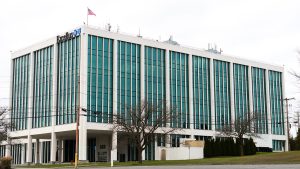The advanced-manufacturing boom along the New York State Thruway corridor continues to be the lead story of upstate’s economic resurgence — with good reason. Micron Technology, Inc.’s highly anticipated plan to break ground on its massive $100 billion memory manufacturing facility north of Syracuse later this year is an important milestone that will be a […]
Already an Subcriber? Log in
Get Instant Access to This Article
Become a Central New York Business Journal subscriber and get immediate access to all of our subscriber-only content and much more.
- Critical Central New York business news and analysis updated daily.
- Immediate access to all subscriber-only content on our website.
- Get a year's worth of the Print Edition of The Central New York Business Journal.
- Special Feature Publications such as the Book of Lists and Revitalize Greater Binghamton, Mohawk Valley, and Syracuse Magazines
Click here to purchase a paywall bypass link for this article.
The advanced-manufacturing boom along the New York State Thruway corridor continues to be the lead story of upstate’s economic resurgence — with good reason. Micron Technology, Inc.’s highly anticipated plan to break ground on its massive $100 billion memory manufacturing facility north of Syracuse later this year is an important milestone that will be a catalyst for the expansion of upstate New York’s high-tech ecosystem.
Down I-81 in the greater Binghamton area, it’s clear that we are well-positioned to capitalize on that growth, given our strategic position located just over one hour south of the project and at the crossroads to the downstate area.
Broome County is already well on its way as 2024 was an incredibly positive year for our collective efforts as a region. Development officials, elected leaders, private businesses, and community advocates worked together to both identify high-growth opportunities and execute on a strategy that positions the Southern Tier as the right fit for leading industries that need access to strong infrastructure, a diversely skilled talent pool, and an affordable area to live, work, and raise a family.
The Broome County Industrial Development Agency last year supported more than $174 million in new, private investment that is driving more than 1,000 jobs and generating $30 million in tax revenue. And that’s only the beginning if we think boldly and work collectively to seize the potential of upstate’s high-tech moment.
That’s exactly what the recently released Southern Tier Cleantech Strategy is designed to help us do. This collaborative regional growth blueprint spearheaded by the region’s IDAs is a forward-looking roadmap laying out a clear path for competing nationally in high-growth sectors like energy storage, clean transportation, and semiconductor packaging.
We’re already a leader in areas like battery-storage research and development, thanks to the success of the Upstate NY Energy Storage Engine, federal Tech Hub designation, and New Energy New York program. Powerhouse educational partners like Binghamton University rival the nation’s top research universities with the right talent and know-how to drive Nobel Prize-winning innovations in clean technology.
But as loud as we’ve been about our leadership in cleantech, we also need to start trumpeting some of our best-kept secrets to a wider audience in order to ensure we’re attracting the right eyes. That the Southern Tier’s cost of living is 5 percent lower than the national average and our housing market is among the most affordable in the country are true assets at a time when the entire nation is still facing inflationary pressure, particularly in the cost of housing.
What we also have — and what we’ve seen work as part of the playbook for Syracuse and other regions — is the right mix-development sites primed for investment. It’s not simply that we have industry-ready pre-developed sites like the Huron Campus in Endicott, on which BAE Systems is expanding with a
$65 million project that could generate more than 130 new jobs. The work we’re doing to explore greenfield developments like the proposed Broome Technology Park — not dissimilar to Onondaga County’s White Pine Commerce Park that landed Micron — is identified in the Southern Tier Cleantech Strategy as a key opportunity the region can’t pass up if we hope to remain competitive.
The bottom line is we can’t afford to miss this moment. The greater Binghamton region has lost more than 12,000 jobs over the past five years, and we continue to struggle with population decline and underemployment. Broome County’s overall and child poverty rates are among the highest in New York state. But we have the tools to reverse those trends and position ourselves for growth simultaneously.
The way in which the region’s educational institutions — from Binghamton University to SUNY Broome to our K-12 schools — have leaned into workforce training and degree opportunities in the clean-energy space is a roadmap for how we can develop programming that fits the needs of new types of industries.
Meanwhile, county officials are leading initiatives like the Broome County Housing Needs Assessment and Strategy and Small Community Fund that are addressing the foundational issues like housing, site readiness, and infrastructure improvements that are essential to attracting top-tier employers and retaining high-quality talent.
In the end, the success of greater Binghamton’s efforts to grow the economy and capitalize on new opportunities is as much a personal mission as it is a professional mission. My family has witnessed firsthand how the original high-tech industry we created here — with trailblazers like IBM and Link — has dramatically shifted over the years. But we’ve also seen how the Southern Tier is in fact still upstate’s gem for raising a family.
We need to look to new opportunities to ensure the next generation is able to reap the benefits that greater Binghamton afforded my generation. I believe we’re on the path to achieve exactly that.
Stacey Duncan is the CEO of the Leadership Alliance, the strategic partnership between the Broome County Industrial Development Agency/Local Development Corporation & the Greater Binghamton Chamber of Commerce. In this role, Duncan serves as the chief executive of both organizations, directing the organizations’ efforts to pursue economic and community development projects for the benefit of all residents of Broome County.
Stacey Duncan is the CEO of the Leadership Alliance, the strategic partnership between the Broome County Industrial Development Agency/Local Development Corporation & the Greater Binghamton Chamber of Commerce. In this role, Duncan serves as the chief executive of both organizations, directing the organizations’ efforts to pursue economic and community development projects for the benefit of all residents of Broome County.



